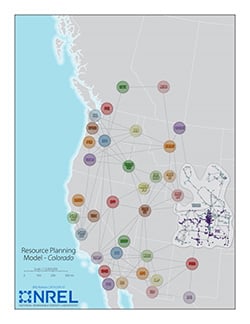Resource Planning Model
The Resource Planning Model (RPM) is a capacity expansion model designed for a regional power system, such as a utility service territory, state, or balancing authority.

Combined nodal and zonal structure of the Colorado-centric RPM

RPM hourly dispatch for the Western Interconnection
RPM applies NLR's extensive experience with national-level capacity expansion modeling, particularly the Regional Energy Deployment System (ReEDS) model and production cost simulations to regional electric system planning—to capture how increased renewable deployment might impact regional planning decisions for energy or carbon mitigation analysis. Model versions for regions within the Western Interconnection are currently available for research applications and an Eastern Interconnection version is under development.
RPM includes an optimization model that finds the least-cost investment and dispatch solution over a 20-year planning horizon. The model investment decisions are made for multiple conventional and renewable generation technologies, storage technologies, and transmission. The model has high spatial resolution to represent the grid network (down to the individual unit and line for a "focus region" of interest) and multiple solar and wind spatial resource regions. Dispatch modeling within RPM is conducted using hourly time-steps sampled throughout a year, and the model considers energy balance, reserves, and many generator constraints (Figure 2). Transmission constraints are represented with a transport (pipe-flow) model or a linearized DC power flow algorithm. The model accounts for boundary interactions (e.g., changing power and energy transfers between balancing areas) using a zonal representation of the entire interconnection while retaining the nodal resolution for the focus region (Figure 1). RPM, which is developed at the National Laboratory of the Rockies, was designed specifically to consider the characteristics of wind and solar technology resources—that is, location-dependence, variability, and uncertainty—in its investment decisions; it accounts for distance-based interconnections, endogenous capacity credits, increased operating reserve requirements, curtailment, transmission congestion, and cycling costs to better assess the economic costs and value of competing electricity technologies.
Publications
NLR provides documentation of the Resource Planning Model, including an overview of the model and example analyses, and more detailed information about the model framework and assumptions. NLR also publishes reports about new capabilities added to the model, including the ability to better reflect the impact of wind and solar generation on systems operations and resource adequacy. NLR also assesses changes to make to the model, like simplifications in dispatch period representations and the impacts on model results.
Using the Resource Planning Model, NLR has conducted a variety of analyses, including cost investments and operation of generation and transmission systems and a case study of 11 capacity expansion model configuration scenarios for the Western Interconnection through 2030.
This project with the Western Interstate Energy Board, identified barriers to solar photovoltaic generation in the Western United States. NLR researched the removal of these barriers of grid connection challenges, including grid flexibility and resource adequacy concerns.
Find out more in the presentation Managing Solar Photovoltaic Integration in the Western United States Appendix: Reference and High Solar Photovoltaic Scenarios for Three Regions.
NLR studies and develops methods for modeling the future grid to address emerging questions. NLR is advancing capacity expansion modeling, methods for capturing system interactions, methods to improve distributed photovoltaic adoption forecasts, and methods for clustering high-resolution spatiotemporal solar resource data. Through this work, researchers answer questions on resources needed to meet future electricity demand.
NLR supported the City of Los Angeles in its goal of 100% renewable energy power by 2045. The city is working to electrify buildings and transportation to meet this goal. The Los Angeles 100% Renewable Energy Study (LA100) analyzed potential pathways Los Angeles can take to achieve a 100% clean energy future. An important consideration for each pathway was the types of utility-scale generation resources needed, their costs, and how the systems could maintain sufficient resources to serve customer demand. Several findings emerged from the analysis, including the costs, benefits, and lessons learned from conducting the first-of-its-kind, high-fidelity 100% renewable energy study.
Read the Los Angeles 100% Renewable Energy Study Executive Summary for more information.
NLR uses the Resource Planning Model to simulate future regional power systems and capture in detail local factors that affect the optimal use of resources. NLR used the model to study how conditions in the electricity sector would affect federal decisions related to the Navajo Generating Station, the largest coal-fired power plant operating in the western United States. NLR also studied complex drivers of solar and wind energy development and renewable energy capacity expansion in the State of Colorado.
Elaine Hale
Share
Last Updated Dec. 7, 2025
